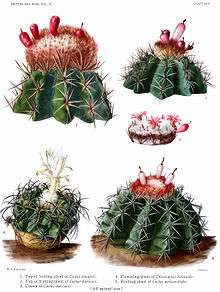Discocactus
Discocactus is a genus of tropical cacti. The name comes from the ancient Greek diskos (=disc) because of its shape. Discocactus plants are endemic to southern Brazil, eastern Bolivia, and northern Paraguay. These species are in the risk of extinction in the wild.
| Discocactus | |
|---|---|
 | |
| Discocactus bahiensis (lower left) | |
| Scientific classification | |
| Kingdom: | Plantae |
| Clade: | Tracheophytes |
| Clade: | Angiosperms |
| Clade: | Eudicots |
| Order: | Caryophyllales |
| Family: | Cactaceae |
| Subfamily: | Cactoideae |
| Tribe: | Trichocereeae |
| Genus: | Discocactus Pfeiff. |
| Species | |
|
Discocactus albispinus | |
The plants have a slightly flattened spherical shape. The areoles bear sharp spines. At the apex of the adult plants, there is a wooly cephalium, white or shaded with yellow or grey. The white nocturnal flowers appear on the sides of the cephalium. The fruits are pink or red and contain black seeds.
 Discocactus horstii
Discocactus horstii Discocactus zehntneri
Discocactus zehntneri Discocactus placentiformis
Discocactus placentiformis- Discocactus araneispinus
 Discocactus boliviensis
Discocactus boliviensis
Bibliography
- Edward F. Anderson : The Cactus Family. Timber Press: Portland (Oregon), 2001, p. 218-221 ISBN 0-88192-498-9
- N. L. Britton, J. N. Rose: The Cactaceae. Descriptions and Illustrations of Plants of the Cactus Family. Washington, 1920
External links
![]()
- (in French) photos on www.AIAPS.org
- (in English) photos on www.cactiguide.com
| Wikimedia Commons has media related to Discocactus. |